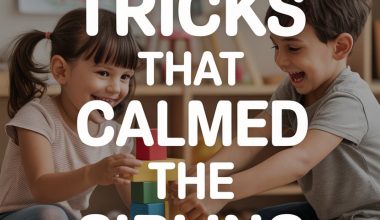Anyone who’s ever tried to slip out of sight while their child’s back is turned knows the unique combination of heartbreak and guilt that separation anxiety brings.
Whether you’re heading off to work, daycare, or just nipping to the loo alone for once, those little faces crumple as though you’ve announced you’re emigrating to the moon.
Welcome to the club—your membership pin is made of dried tears and slightly chewed stickers.
Separation anxiety doesn’t mean you’ve spoiled your child or that you’re somehow doing it all wrong. It means your little one loves you fiercely, wants to keep you close, and hasn’t quite mastered the art of goodbyes.
Here’s what you can do to soothe that storm, no guilt required.
What Separation Anxiety Really Is
Separation anxiety isn’t a parenting failure. It’s a developmentally appropriate phase that crops up as babies start to understand object permanence (that people and things exist even when you can’t see them).
This realisation tends to arrive somewhere between six months and three years old, though the timeline can vary. Suddenly, your absence feels like a cosmic event: you’re gone, and what if you never come back?
It’s nature’s way of keeping little ones close to their caregivers. Evolutionary logic, though, doesn’t help you when you’re peeling a sobbing child off your leg at nursery.
Why Guilt Loves to Tag Along
The guilt creeps in quietly.
You see the tears, the trembling lips, and the outstretched arms, and your internal monologue goes full tilt: What if I’m scarring them for life? Should I be staying home? Maybe a little more TV time and cuddles will fix this?
Here’s the truth: separation anxiety isn’t caused by leaving. If anything, it’s a sign of a secure attachment.
Your child trusts you’ll come back. It’s just that patience isn’t exactly a toddler’s strong suit.
Keep Goodbyes Short and Sweet
Every instinct might tell you to sneak out quietly, but research shows a consistent goodbye routine actually helps your child adjust.
Say a quick, loving goodbye (“Mummy/Daddy loves you, see you soon!”), then go—no drawn-out explanations, no sudden disappearances.
A lengthy farewell, while well-intentioned, can ramp up anxiety. The more you linger, the more your child senses something’s off.
And if you try the old ninja exit? That might earn you a few minutes’ peace, but it can make a child feel abandoned.
Create Predictable Routines
Children adore routine, even if their sock choices suggest otherwise.
If your child knows what to expect when you separate—a hug, a special wave, maybe a secret handshake—they’ll start to gain confidence that these partings aren’t permanent.
Some families use a transitional object: a favourite blanket, toy, or even a sticker you both wear as a reminder you’ll be together again.
The American Academy of Pediatrics recommends this very approach, especially for younger children.
Practice Separations in Small Doses
If every separation is a major event, try dialling down the drama with some practice. Short, positive separations can help your child build resilience.
Step out of the room for a minute to grab a cuppa, or leave your child with a trusted friend while you fetch the post.
Repetition helps your child learn that you go—and you come back. It’s a bit like exposure therapy, minus the spreadsheets and lab coats.
Talk About It—But Don’t Overdo It
You don’t need to schedule a TED Talk about feelings every morning, but a little conversation goes a long way. Acknowledge your child’s emotions: “You’re sad when I go to work. That’s tough.”
Empathy tells them their feelings matter.
No need to launch into a play-by-play of your workday or make elaborate promises. A simple, “I always come back!” is enough.
Make Reunions Joyful
The way you reunite matters. Greet your child with warmth, smiles, and enthusiasm—even if you’ve had a day that only caffeine survived.
This positive association reinforces the idea that separations end with happy reunions.
If you look anxious or guilty, your child picks up on it. Fake it till you make it (or until you can have that glass of wine after bedtime).
Manage Your Own Emotions
Here’s something they don’t always tell you: sometimes, parents are the ones with separation anxiety. It’s natural to feel nervous or even a little sad when saying goodbye, especially if your child is struggling.
Children are emotional detectives—if you’re tense, they sense it. Take a few deep breaths and remind yourself that this is a normal, healthy phase.
Some parents find that a bit of self-talk (“She’s safe, she’s loved, I’ll see her soon”) makes a surprising difference.
Stay Consistent, Even When It’s Hard
Once you’ve established a routine, stick with it. Consistency helps your child build confidence.
If they know the drop-off always happens at the same time, with the same goodbye, they begin to trust the rhythm.
Resist the urge to change up the plan when tears flow. Consistency is the best comfort you can offer—alongside hugs and a decent snack stash.
Enlist Support from Caregivers and Teachers
If your child goes to childcare, nursery, or has a nanny, communicate openly about separation anxiety. Experienced carers have seen it all.
They can help by distracting your child, offering comfort, and sticking to routines.
Ask about their strategies and share what works at home. Some settings have a settling-in period where you stay for a while before making your exit—worth considering if possible.
Watch for Signs of Something More Serious
For most children, separation anxiety is a passing phase. Occasionally, though, it lingers or becomes overwhelming.
If your child is inconsolable for hours, refuses to eat or sleep, or shows persistent physical symptoms (like stomach aches) around separation, it might be time for a chat with your paediatrician.
Persistent separation anxiety could be linked to separation anxiety disorder, which often responds well to early support and gentle interventions.
No shame, no blame—just extra help when it’s needed.
Don’t Compare Yourself to the Other Parents at the School Gate
Every child is different. Some waltz into nursery like they own the place; others cling like a barnacle during high tide.
Social media doesn’t help—those cheery goodbye photos post precisely none of the tearful reality.
Comparison only fuels guilt. Your child’s feelings are unique, and your approach will be too.
If your child needs an extra cuddle, so be it. If you need to cry in the car park, welcome to the club.
Self-Care Isn’t Selfish
Pouring from an empty cup never works, no matter how heroic your intentions. If separation anxiety is taking a toll, look for small ways to care for yourself.
Phone a friend, take a walk, or enjoy a sneaky biscuit in the pantry.
Prioritising your wellbeing helps you show up as a calmer, more confident parent. That’s good for you—and for your child.
When Your Child is Older (Yes, It Can Happen Then Too)
Separation anxiety isn’t just for babies and toddlers. School-age children—and even teens—can struggle with goodbyes, especially during transitions like starting a new school or after family changes.
Be honest and supportive. Validate their feelings, keep routines predictable, and give them a role in the process (like walking themselves to the door).
Independence grows slowly, and sometimes it needs a nudge and a little reassurance.
Bedtime Separation Anxiety: The Night Shift
Night-time brings its own brand of parting sorrows. If your child resists bedtime or wakes up looking for you, try a predictable routine with extra comfort—think stories, snuggles, and a favourite soft toy.
If fear of separation keeps cropping up, a visual schedule can help: a simple chart showing what happens at bedtime and when you’ll see each other in the morning.
Sometimes, just knowing what comes next brings much-needed calm.
When to Seek Extra Help
If anxiety starts interfering with daily life, don’t hesitate to reach out. Teachers, paediatricians, and child psychologists have a wealth of experience and practical strategies.
Early intervention can make all the difference.
You’re not alone. Families everywhere are muddling through these same goodbyes (and the occasional, triumphant hello).
Embracing the Messy, Marvelous Goodbyes
Separation anxiety tugs at the heart—yours and your child’s. Every tear, every wobbly wave, every too-long hug is proof of love and attachment.
This is a season, not a sentence.
Soon enough, your little one will be running off to playdates, school trips, and adventures you can barely keep up with, leaving you to wonder how they ever clung so tightly.
For now, practice those short goodbyes, trust the routine, and remember: the guilt is optional. The love is not.





